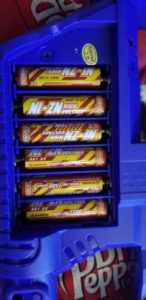
NiZn Batteries – Why Isn’t This a Thing?
April 16, 2019After seeing this post (with no replies) and looking into the topic, I grabbed a few Nickel-Zinc batteries of my own for testing. At least in stock blasters, the AA-sized batteries boost dart velocity by a noticeable margin. In addition, they’re rechargeable, can supply decent amounts of current, and are fairly inexpensive. However, there’s issues in reliability and longevity, and higher voltages aren’t always what they’re cracked up to be. In the end, there’s really not much to be gained in terms of Nerf, as far as I can tell.
(This is from the “stock blaster” perspective. If you’re actively trying to modify your blaster, there are plenty of guides on rewiring blasters as well as choosing appropriate batteries).
The Battery Basics
Nickel-Zinc (NiZn) batteries are similar to nickel metal hydride (NiMH) batteries, but work at a higher voltage; NiMH has a nominal 1.2V, while NiZn has a nominal voltage of 1.65V. Charging is different (and requires a separate charger). However, it follows a similar profile as NiMH, holding a steady voltage while under use until it reaches the low end of its capacity.
It’s an old technology, with Thomas Edison himself holding a 1901 patent on a rechargeable NiZn battery system. However, the tech has seemingly fallen in and out of favor over the years. Early batteries used in vehicles didn’t have long lives in terms of the number of charging cycles, while later (better) attempts met other kinds of resistance – the rise of reliable NiMH and Lithium Ion batteries. Among other things, the Zinc electrode has a nasty habit of forming dendrites within the cell that can eat away at capacity and eventually render the battery useless.
Generally, NiZn cells work well with robust electronics that don’t like the lower voltages provided by NiMH.
Stock Blaster Usage
 Note that I tested these batteries in particular, from HobbyKing.
Note that I tested these batteries in particular, from HobbyKing.
NiZn batteries operate at a higher voltage than alkaline batteries. This means that, without the proper circuitry to step down the voltage, they do have the potential to fry cheap circuit boards. That being said, if you’re simply feeding current to flywheel motors, they can potentially drive the motors at higher speeds. If they can supply the increased current demand, then you can keep the motors from lagging between shots.
The stock Stryfe I tested fired 62-65fps on both alkaline and NiMH batteries. On NiZn batteries, it averaged 77fps.
Using an Adventure Force Double Trouble (which runs hot for a blaster), the velocity jumped from 92fps to 100fps. This of course requires six cells.
However…
The NiZn batteries I tested did what I expected, running the blaster motors faster. However, there are a few things to consider before deciding you should adopt them.
- NiZn batteries still have a fairly high self-discharge rate, meaning that they will lose charge just by sitting there unused. When we have high capacity, low self-discharge NiMH batteries that can sit in a bin for months and still power a blaster just fine, other options don’t seem as appealing.
- NiZn cells of this size just don’t seem to last as long. Even with improvements, the batteries can still short internally and simply fail after fewer charging cycles than other batteries. There’s a reason you really don’t see hobby-sized NiZn packs – cell failure rates mean most people will just have a pack they want to throw away.
- NiZn requires its own charger. Or at least one that can be programmed to meet its needs.
- There’s simply a limit to the performance gains you can get out of a battery swap. Even with a higher voltage, you might run into issues with battery trays heating up (due to their resistance), or a sensitive thermistor slowing things down due to the increased current demand through all those tiny wires. Granted, the risks are minimal for such a small step in voltage, but it’s still a possibility. Especially in off brand blasters that tend to wire straight to the motors without any extra parts in between.
- Not all electronics are made to handle higher voltage inputs. While I’m sure someone will try throwing these into a “C” adapter to use in a Regulator, etc, Nerf blasters are made for use with alkaline batteries. Running higher voltages does run the risk of frying boards inside if they can’t properly step down the voltage and limit the power feeding into them.
Last Thoughts
In the end, I’d prefer reliability over any slight performance gains. My opinion? Stick with the low self-discharge NiMH batteries if you want to save money and have blasters that will work even if you forget to charge them until a month later. I’ll continue testing the usefulness of these batteries, so opinions may change. However, do know this: if you’re chasing after performance gains, you’re better off starting down the road of actual blaster modification than you are trying to simply sub in different batteries.
NiZn cells do have some specialized uses, I’m just not sure that Nerf blasters are one of them yet.


